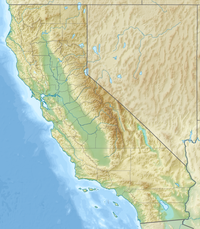Sutter Buttes
| Sutter Buttes | |
|---|---|

Bird's eye view of the Sutter Buttes, rising over the town of Yuba City, California
|
|
| Highest point | |
| Elevation | 2122+ feet (647+ m) |
| Listing | California county high pt 56th |
| Geography | |
|
Sutter Buttes, California
|
|
| Country | United States |
| State | California |
| Region | Sacramento Valley |
| District | Sutter County |
| Range coordinates | 39°12′21″N 121°49′13″W / 39.2057°N 121.8202°WCoordinates: 39°12′21″N 121°49′13″W / 39.2057°N 121.8202°W |
| Topo map | USGS Sutter Buttes |
| Geology | |
| Type of rock | volcanic neck |
The Sutter Buttes, formerly known as the Marysville Buttes, are a small circular complex of eroded volcanic lava domes which rise as buttes above the flat plains of the Sacramento Valley in Sutter County, Northern California.
The summit of South Butte, at 2122+ feet (647+ m), is the highest point in Sutter Buttes and the highest point in Sutter County. The Buttes are located just outside Yuba City in the Sacramento Valley, the northern part of the Central Valley. Located at the base of the mountain is the small town of Sutter. They are named for John Sutter, who received a large land grant from the Mexican government. The Sutter Buttes are sometimes referred to as the world's smallest mountain range.
The small range forms a rough circle approximately 10 miles (16 km) from north to south and east to west.
The Sutter Buttes were formed about 1.6 million years ago in the early Epoch by volcanic activity. The mountains are the remnants of a volcano that has been dormant for over a million years. The eruptions continued until about 1.4 million years ago. Some geological references suggest that it represents the southernmost boundary of the Cascade Volcanoes, but there are significant differences in age and form compared to the other volcanoes in that range. Others suggest that its age places it with the volcanic elements of the California Coast Ranges; its composition is closer to that range but does have significant differences. The volcano is believed to have erupted along a now inactive fault line. The questions about their origin and connection to other regional volcanic activity are the subject of ongoing research.
The rugged central part of the Buttes has a stony brown sandy loam soil of variable depth and good to somewhat excessive drainage. The smoother perimeter has more variable soil with clay or silt loam areas among the sandy loams. These soils support grassland or oak woodland. The Sutter Buttes contain many flora and fauna species. Wildflowers are represented by numerous taxa; included in these many wildflowers is the yellow mariposa lily, Calochortus luteus.
...
Wikipedia

